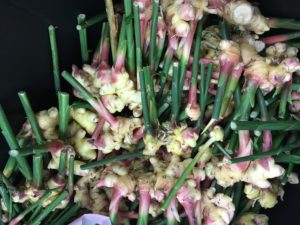Edible Baby Ginger: A Spicy, Super Addition to Home Gardens
go.ncsu.edu/readext?656977
en Español / em Português
El inglés es el idioma de control de esta página. En la medida en que haya algún conflicto entre la traducción al inglés y la traducción, el inglés prevalece.
Al hacer clic en el enlace de traducción se activa un servicio de traducción gratuito para convertir la página al español. Al igual que con cualquier traducción por Internet, la conversión no es sensible al contexto y puede que no traduzca el texto en su significado original. NC State Extension no garantiza la exactitud del texto traducido. Por favor, tenga en cuenta que algunas aplicaciones y/o servicios pueden no funcionar como se espera cuando se traducen.
Português
Inglês é o idioma de controle desta página. Na medida que haja algum conflito entre o texto original em Inglês e a tradução, o Inglês prevalece.
Ao clicar no link de tradução, um serviço gratuito de tradução será ativado para converter a página para o Português. Como em qualquer tradução pela internet, a conversão não é sensivel ao contexto e pode não ocorrer a tradução para o significado orginal. O serviço de Extensão da Carolina do Norte (NC State Extension) não garante a exatidão do texto traduzido. Por favor, observe que algumas funções ou serviços podem não funcionar como esperado após a tradução.
English
English is the controlling language of this page. To the extent there is any conflict between the English text and the translation, English controls.
Clicking on the translation link activates a free translation service to convert the page to Spanish. As with any Internet translation, the conversion is not context-sensitive and may not translate the text to its original meaning. NC State Extension does not guarantee the accuracy of the translated text. Please note that some applications and/or services may not function as expected when translated.
Collapse ▲Common Ginger (Zingiber officinale) is native to tropical parts of Asia and is grown for its edible rhizome. Known for its anti-inflammatory properties, ginger has a warming flavor and is popular in teas and recipes. In North Carolina, ginger can be grown to a thin-skinned ‘baby’ form in zone 7 or warmer. ‘Baby’ ginger does not usually require peeling, but does need to be refrigerated or processed upon

Image by Eli Snyder CC BY-NC
harvest.
New sprouts will initiate from mature rhizomes when placed in moist soilless media at 72-80℉ for six weeks, or when moist rhizomes are placed in a plastic bag for several weeks. Harden any sprouts and transplant into well-drained soil with high organic matter after danger of frost. Some seed companies sell pre-sprouted ginger for transplanting. Ginger grows well in shade, but rhizome harvest may be greater in full sun. Let your ginger grow nearly until frost for maximum yield. Then, harvest and enjoy your homegrown superfood!



